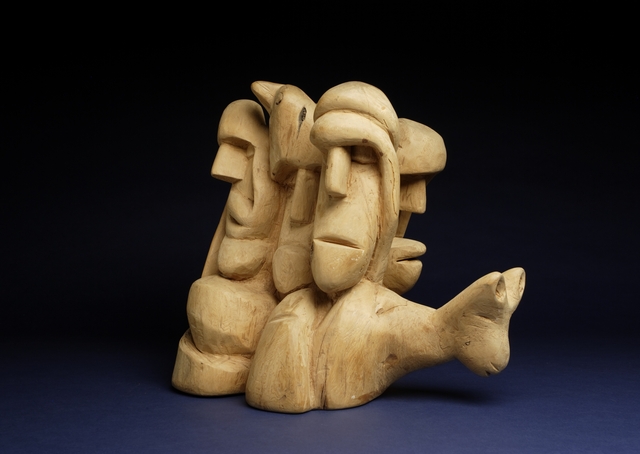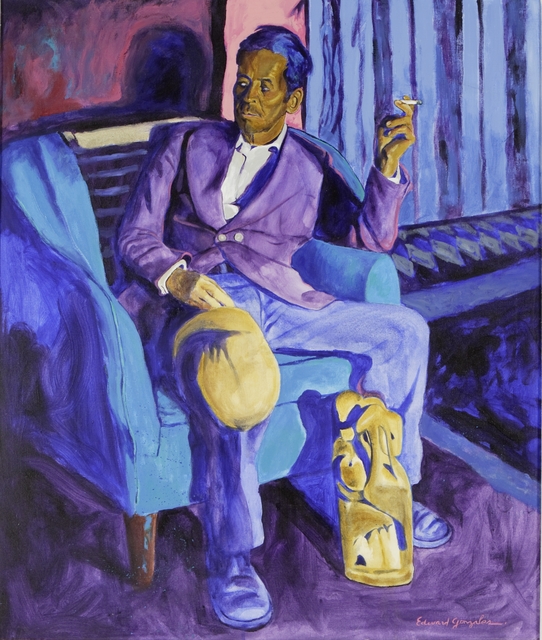The April cover of Artforum depicts Damien Hirst’s For the Love of God , a skull made of platinum, diamonds and human teeth. It’s dazzling. Its function is to start conversations about art and money; or, more pointedly, conversations about how money is the religion that defines the value of art. The work is emblematic of the conflation of money and meaning in our current art market—come on, it cost more than $16 million to make; how could it not mean anything?Though it may be anathema to make connections between For the Love of God and the work of Patrocinio Barela (1908-1964), on view in Caminos Distintos: Patrocinio Barela and Edward Gonzales in New Mexico at the National Hispanic Cultural Center, I couldn’t help it. I began to think of talismans and santos and the relative power of specific materials: diamonds and wood.Hirst made an object directed at the art world from within it, brimming with opulence and irony. Barela, on the other hand, lacked Hirst’s level of affectation, attempting to make highly personal, figurative pieces his entire life. The gap between the two artists is great, but I find it compelling in terms of our understanding of how images and forms operate and how we draw conclusions about what does or doesn’t have value. A highly influential Taos sculptor, Barela received much acclaim during his lifetime, the most noteworthy of which was his inclusion in the 1936 exhibition New Horizons of American Art at the Museum of Modern Art. There are 55 of his woodcarvings in Caminos Distintos on display through Aug. 10. The fascination in the work hinges on its presumptive santero roots, which is ultimately waylaid by his intuitive, stream-of-conscious approach. I’m certainly not the first to write about Barela’s straddling of tradition and modernism, but it seems to be at the heart of what’s happening. To that end, Barela’s work is important for redefining the image of Hispanic culture and art, and perhaps for shifting the definition of what it means to be contemporary. What I find most interesting is how the work fails at being strictly traditional, rooted instead in a process that sidesteps the programmatic in favor of emotional and conceptual depth.The power in a piece like Christ and the Last Judgment is undeniable. Two spatial ideas are held at once: The pious man ascends to Heaven while the heathen descends into Hell. It’s necessary to move around the hourglass-shaped work to see each man moving to his respective sphere, while the forms grow in ambiguous ways, multiplying possible readings. That very ambiguity serves to complicate the work; human heads become birds or lambs as you shift your vantage point and see not only the Holy Family, but maybe your family and the grain of the wood and the direction it grew. It is the complex nature of being Hispanic in New Mexico that’s brought up in the paintings and prints of Edward Gonzales. His historically based paintings—like La Clinica (after Collier) —aim to depict the humanity of Nuevo Mexicano village life. Working from photographs, he depicts the importance of education and the relationship to the land, giving new life and focus to those moments. If you forget the fact that a lot of the paintings seem mired in a kind of French-y, Millet-esque description, you can get to the crux of his effort, which is to challenge stereotypes and represent Nuevo Mexicano life from within it, rather than from outside. Barela and Gonzales are connected by the legacy they have created through their artistic influence and their efforts to broaden the understanding of Hispanic art in New Mexico.
Caminos Distintos , featuring works by Patrocinio Barela and Edward Gonzales, is on display at the National Hispanic Cultural Center (1701 Fourth Street SW, 246-2261) through Aug. 10. Gallery hours are 10 a.m. to 5 p.m. Tuesday through Sunday, closed Mondays. Admission is $3 adults, $2 seniors, free for children 16-and-under and free for everyone on Sundays. David Leigh is the former director of Donkey Gallery.










